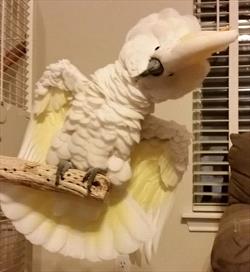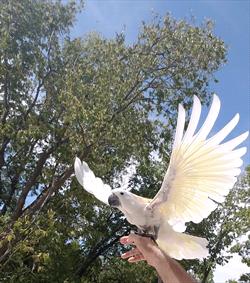Nikolai wings with feathers

There are no missing feathers on the leading edge of the wing. Photo courtesy Dr. Christi Corp-Minamiji
Feather destructive behavior (also called feather picking) happens when birds damage their feathers with their beak. This is not a disease by itself, but a symptom of an underlying problem. Feather picking can cause baldness, and in severe cases it can damage underlying tissues. It is widespread among captive parrots, especially grey parrots and cockatoos, but any pet bird can be affected.
Left unchecked, feather picking has serious consequences. Besides causing baldness or a lack of nice feathers, feather picking affects a bird’s ability to keep itself warm, can cause bleeding, infections, and permanent damage to the feather follicle, thus preventing normal regrowth. This can progress to an obsessive-compulsive disorder, making treatment much more difficult.
Causes
Feather picking is a consequence of captivity. This behavior is much less common in wild birds. The conditions of captivity provide less stimulation than a bird has in the wild, where they spend their time avoiding predators, exploring their environment, socializing, etc. A bird may feather pick in response to decreased levels of mental and social stimulation.
Causes are divided into medical and non-medical. Several can contribute to feather picking at the same time. While not listed below, any disease that causes pain, discomfort, irritation or itch can be a medical cause.
Non-medical causes
- Environmental
- nutritional deficiency
- airborne and/or topical toxins
- low humidity
- small cage or poor cage design
- overcrowding
- social isolation
- unable to perform natural behaviors
- hand-rearing and improper socialization
- unpredictable environment
- Behavioral
- individual personality
- boredom
- stress
- anxiety or phobia
- sleep deprivation
- attention-seeking behavior
Medical Causes
- Primary feather and skin diseases
- viral diseases
- bacterial or fungal skin infections
- feather dysplasia (abnormal feather growth)
- allergies - although this is poorly understood
Nikolai wings

There are missing feathers on the leading edge of the wing due to feather picking. Photo courtesy of Dr. Christy Corp-Minamiji
Recognizing Feather Picking in your Bird
Any feather your bird can reach is fair game, although the chest, undersurface of the wing and inner thigh are most commonly affected. Feathers on the head and neck are unaffected because their beak cannot reach these areas. To spot changes as soon as possible, be familiar with what your bird’s feathers and general appearance normally look like as well as what they should look like. Your bird’s feathers should be tidy and sleek. If you notice any broken feathers or bald spots, consult your veterinarian.
Diagnosis
Diagnosing the underlying cause(s) of feather picking can be a long process and requires excellent cooperation between you and your veterinarian. With non-medical causes so common, it is important to provide your veterinarian with a thorough history of your bird’s behavior and environment. This helps your veterinarian rule in or out possible causes. In addition, your veterinarian will perform a physical examination and an assessment of your bird.
Once your veterinarian has a good list of possible causes, they may decide further specific tests are needed. These can include bloodwork, x-rays, skin biopsies, and more. These tests are tailored to your individual bird.
Treatment
Realistically, eliminating feather picking in each bird is not possible. Feather picking is a complex problem with different contributing factors. A reduction in the amount of feather picking can be considered a success.
The basis for several treatment strategies is to provide your bird with healthy, more desirable alternatives to feather picking. Feather picking serves a purpose to your bird. It can help birds cope with boredom, stress, anxiety and other unpleasant feelings. Treatment plans are designed to address the underlying reason of why your bird is picking. How they do so should be tailored to your bird and your lifestyle. The most impressive treatment plans will fail if they cannot be carried out.
Different Therapeutic Strategies
- Medical treatment depends on the cause
- Environmental enrichment
- Foraging so the bird has to physically and mentally work to get food
- Physical objects for play such as toys, swings, ladders, mirrors
- Physical space to allow flying, running, swimming
- Sensory enrichment to use bird’s sense of sight, hearing, smell and touch, such as having a “Room with a view,” background noises, videos, cage proximity to people
- Social interaction with other birds and people, even indirectly by seeing and hearing others or directly with a cage mate
- Encourage problem solving, learning, and controlling some feature in the bird's environment
- Free flight in house
A lot of work and time go into creating a treatment plan and carrying it out. It is important to work closely with your veterinarian. Some strategies are slowly introduced to prevent over-stimulation, stress, and other risks. Depending on your bird’s response and what works best, your treatment plan will change as time goes on.
Temporary Fixes
Temporary measures that reduce feather picking include Elizabethan collars, neck braces, fabric jackets or vests, and applying foul-tasting substances to the areas being picked. These tactics are not solutions. Your bird is still upset, agitated, or sick and will feather pick if given the chance.
Prognosis
Feather picking requires a fair amount of persistence and patience from both the owner and veterinarian. Despite an excellent treatment plan and teamwork, success may mean only a reduction of feather picking rather than eliminating it entirely. Catching it early improves the chance of success.